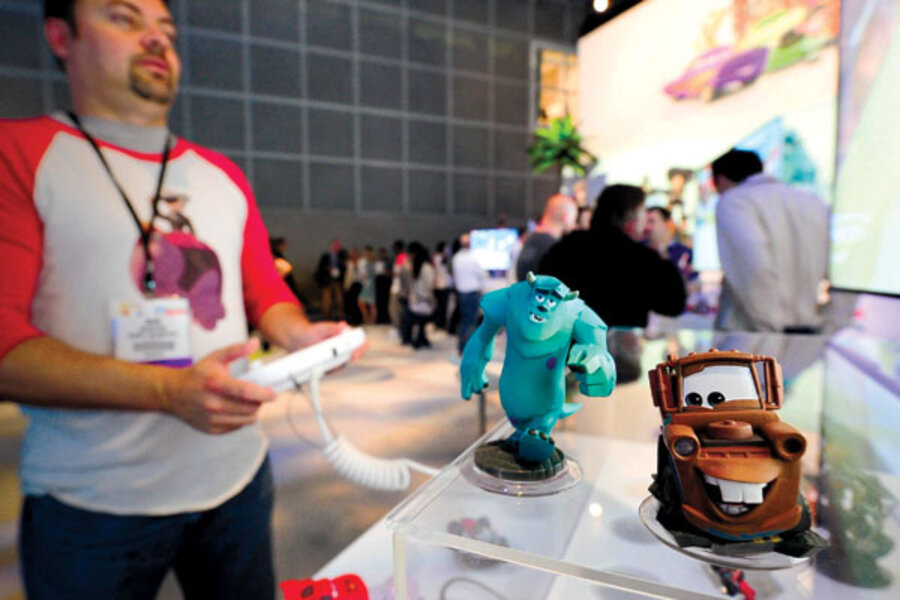Disney Infinity and Skylanders: Toy/game mash-up is retail bonanza
Loading...
This year's most popular action figures blur the lines between toys and games.
The new video game Disney Infinity comes with a plastic pedestal and three action figures, each of a different Disney character. Place Lightning McQueen atop the pedestal and the "Cars" hot rod appears inside the game. Swap in the Jack Sparrow figurine for a swashbuckling romp through "Pirates of the Caribbean."
Each character comes with its own story and several hours of game play. If players grow tired of the starter set, they can unlock new worlds by purchasing additional action figures. New figures cost between $10 and $17 each.
At a time when toy sales have been flat for years, this melding of the digital and the physical has shaken up both industries.
While it's too soon to tell if Disney Infinity is a hit, its chief competitor has dominated toy stores. Skylanders follows essentially the same formula. Players swap through a menagerie of monsters that exist both in pixel and toy form. Additional figures, which are available at major retailers, unlock new areas and challenges.
Activision, the company behind Skylanders, announced in July that its genre-defying toys have outsold all other action-figure properties in the United States and Europe during the first six months of the year. Over the same period, the game's sequel, Skylanders: Giants, made more money than any other video game.
Melding toys and games has turned into a $1.5 billion business for Activision.
" 'Retail is dying,' that's what everyone else is saying, whereas Activision has taken a completely different approach, and it's been a huge success," says Kris Graft, editor in chief of Gamasutra, an industry news outlet written for the people who make games. "It's no wonder that Disney is putting a lot of weight behind Infinity."
Disney has released 17 figurines across five franchises and announced 12 upcoming toys, including characters from "Toy Story," "Fantasia," and the TV show "Phineas and Ferb."
Since Disney owns Pixar, Marvel, ABC, and the "Star Wars" franchise, it could release new Disney Infinity figures indefinitely – so that the game lives up to its name.
The success of Skylanders flies in the face of many game companies that are pushing away from retail sales, opting instead for in-game purchases. So-called free-to-play games lure in players by forgoing an admission price and then selling extras to fans within the game.
For example, the free puzzle game Candy Crush Saga on iPhone, Android, and Facebook charges people for power-ups, which become increasingly necessary as players dive deeper into the game. By giving people a taste, free of charge, the average player winds up paying about $3.17, much more than the traditional 99-cent sticker price for phone applications.
When you add it all up, Candy Crush Saga pulls in an estimated $808,000 a day, according to the tracking firm Think Gaming.
While Disney Infinity welcomes characters from many different movies, the game has erected walls between franchises: Mr. Incredible cannot visit Monsters University. However, as players march through the story mode, they unlock building blocks – castles, helicopters, waterfalls, the house from "Up" – for the game's Toy Box mode. Here, people can design their own world out of pieces from any of the Disney franchises. Just as the core game borrows from Skylanders, so the Toy Box mode lifts from LEGO, Erector, and the popular adventure/building video game Minecraft.
"Honestly, these are the types of games that I like to see come out for kids," says Mr. Graft, whose two boys love Skylanders and Minecraft. "If Disney can borrow ideas from them, great."
Disney Infinity and Skylanders are available for PlayStation 3, Xbox 360, Nintendo 3DS, Wii, and Wii U.
For more on how technology intersects daily life, follow Chris on Twitter @venturenaut.
The original version of this article ran in the September 9 issue of the Christian Science Monitor magazine.







